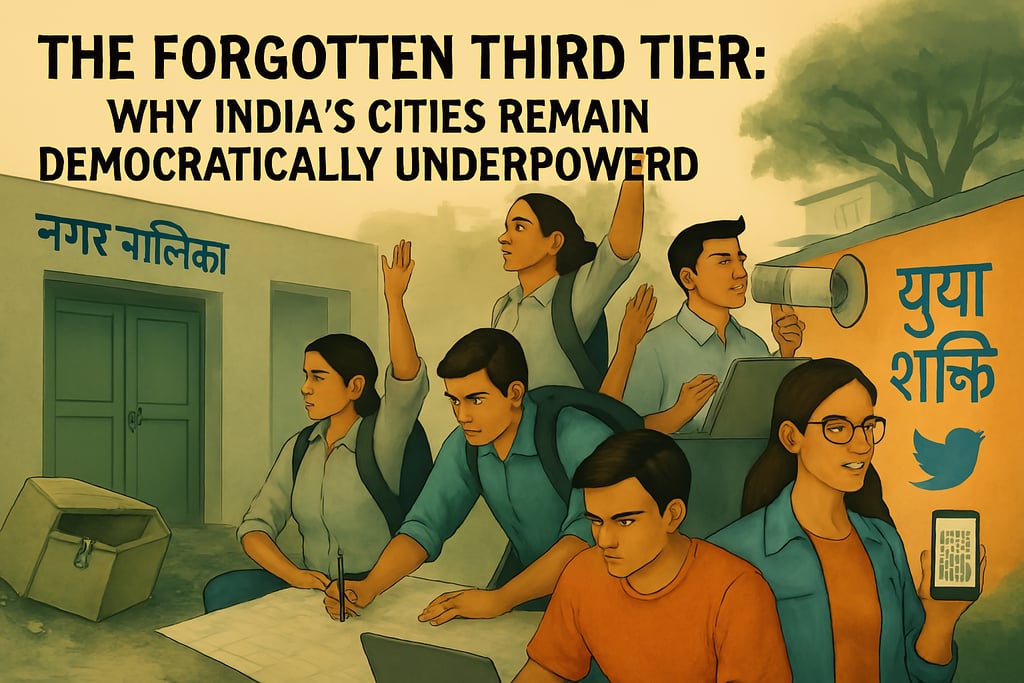YUVA AUR PRAKRTI KE SATH
The Forgotten Third Tier: Why India’s Cities Remain Democratically Underpowered
Blog post description.
Aditya Janu
1/2/20243 min read


India’s Constitution recognises three levels of government: Union, State, and Local. Yet when it comes to urban governance, the third tier remains the weakest link — more symbolic than sovereign. While rural panchayats have gained limited but real authority under the 73rd Amendment, Indian cities continue to be governed by fragile councils overshadowed by state governments and parastatal agencies.
This democratic deficit has serious consequences for nearly 500 million Indians projected to live in cities by 2036 (Census projections). It matters even more for young citizens who will inherit these urban spaces — yet have little influence over how they are planned and managed.
Constitutional Promise vs. Urban Reality
The 74th Constitutional Amendment Act, 1992, aimed to transform urban local bodies (ULBs) into self-governing institutions. It mandated:
Directly elected municipal councils (Article 243R)
Ward committees in cities with populations over 3 lakh (Article 243S)
Devolution of 18 functions listed in the Twelfth Schedule (urban planning, water supply, public health, etc.)
State Finance Commissions to recommend revenue sharing
Yet three decades later, most of these reforms remain partially implemented:
Fewer than 15 Indian states have set up fully functional ward committees (CEPT University study, 2020).
In many large cities, mayors are indirectly elected or rotated annually, holding largely ceremonial roles.
Functional devolution: A 2021 study by IIPA found that in most states, urban local bodies exercise control over fewer than half the Twelfth Schedule subjects.
Fiscal autonomy: ULBs generate less than 1% of India’s GDP; compare this with 6% in South Africa and over 20% in Brazil (NIUA, 2022).
The Power Imbalance
State governments continue to:
Appoint municipal commissioners (often senior IAS officers) who exercise real executive power.
Control urban planning, water supply, and transport through parastatals (e.g., development authorities, metro rail corporations) beyond the city council’s remit.
Dictate municipal budgets through approvals and grants.
This imbalance makes city councils politically visible but administratively toothless.
Why it Matters
Urban local bodies are meant to manage:
Solid waste, drainage, and sanitation — critical for public health.
Urban planning and zoning — key for affordable housing.
Local roads and transport — affecting congestion and pollution.
Green spaces and climate adaptation — essential for heat resilience.
Weak ULBs mean slow responses to urban flooding, poor air quality governance, and reactive rather than preventive planning.
For young urban residents — nearly 41% of India’s urban population is under 25 (Census 2011) — this democratic vacuum directly shapes daily life and future well-being.
International Comparisons
Cities elsewhere have stronger local democracies:
London: Directly elected Mayor with budgetary control over transport and policing (£19bn budget).
Seoul: Directly elected Mayor plus local assemblies; city’s budget over USD 30 billion.
São Paulo & Porto Alegre: Cities run participatory budgeting, with citizens directly allocating up to 20% of municipal capital spending.
These examples show that city governments, when empowered, innovate faster and plan more inclusively.
Reform Pathways
To bridge India’s urban democratic deficit:
Directly elected mayors with fixed terms and real executive authority — as recommended by the Second Administrative Reforms Commission (2007).
Mandatory and funded ward committees to engage citizens at neighbourhood scale.
Functional devolution of all 18 Twelfth Schedule subjects, with clear responsibility maps.
Fiscal empowerment:
Modernise property tax (current collection efficiency is under 60% in most cities; RBI, 2020).
Share a fixed share of state GST revenue.
Ease rules for municipal bonds (currently only ~0.05% of urban finance).
Transparency: Online dashboards of ward budgets, live-streamed council sessions, and citizen audits.
Beyond Symbolism
The 74th Amendment laid the legal foundation, but political reluctance kept power concentrated in state capitals. Cities became economic engines without democratic engines.
For the next generation — who will inherit denser, hotter, and more complex cities — finishing this reform isn’t optional. It’s essential for liveability, accountability, and sustainability.
Completing urban decentralisation would do more than fix potholes. It would bring democracy home: to the neighbourhoods and streets where it matters most.
